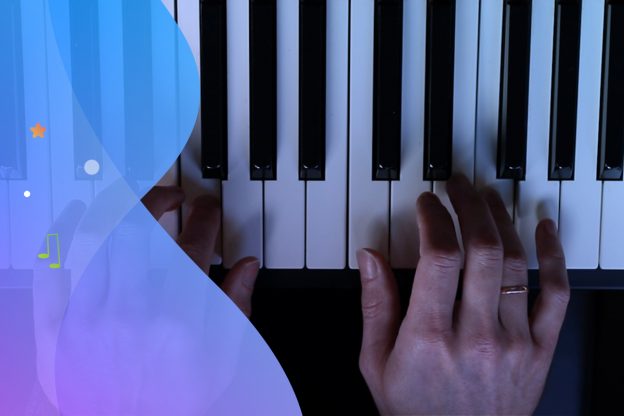Musical explorers, welcome to our new series dedicated to the warm-up of your hands before you start kicking out jams on your piano. We’ll cover some basics, which can help you to improve your technical skills. Since it’s Jamuary here’s the challenge to keep you motivated: Try to do this exercise before you start jamming.
Estimated reading time: 6 minutes
In this blog on finger fitness you’ll find
Fingers
For both hands the fingers are numbered from 1 to 5, starting with the thumb with number 1 and going up to pinky with the number 5. Now we’re going to talk about the basic exercise on how to train the fingers of the left and right hand.

Figure 1 – The numbers for the fingers.
Often, each finger hovers over a specific key on a piano keyboard, ready to play when needed. You can see these numbers for your fingers in the piano notes. They stay there to help you play certain musical lines more easily or smoother by using different fingers going from one note to another.
For instance, if you play C major triad, the fingers in the chart can look like the picture below:

Figure 2 – Example of notes with finger numbers.
In this picture you can clearly see that the note C has to be played with finger 1, the note E with finger 3, and the G with finger 5. This finger combination provides you with a comfortable way to play this passage. Therefore, it’s important to know how each of the fingers is indicated and how you can train your fingers.
How to train your fingers
Here is a basic exercise on how to train your fingers of both hands, so that you hit the right keys at the right time on the keyboard. You can do this exercise simultaneously with both your right and left hand, or you can start practicing each hand independently.
Right hand exercise
Let’s start with the right hand. First, choose the octave you’re going to practice. You can read more about the term Octave in our Music Dictionary. Secondly, place your fingers as follows: finger 1 on the key of C; finger 2 on the D; finger 3 on the E key; finger 4 on the F, and finger 5 on the G. Don’t press these keys yet, just hover your fingers above them. See the picture below.

Figure 3 – Fingers of the right hand on the piano keyboard.
Now your right hand is ready. Start the exercise by playing from the C up to the G. The important thing to keep in mind is, that only your fingers are doing the work, your hand doesn’t make any extra movements. Your shoulders and your hand should be relaxed. After you reach the G with your 5th finger, play the exercise backwards starting from the G note.
Ready? Nice! Now you can move your right hand to a different range of notes, for instance, from D to A, and repeat the exercise back and forth.
Left hand exercise
For the left hand you can do the same. First, choose the octave you’re going to practice. Secondly, place your fingers as follows: finger 5 on the key of C; finger 4 on the D; finger 3 on the E key; finger 2 on the F, and finger 1 on the G. See the picture below.

Figure 4 – Fingers of the left hand on the piano keyboard.
Just like with your right hand, keep in mind to only use your fingers. The rest of your hand, shoulder, and arm must remain relaxed. After you’re done, just repeat the exercise starting from a different octave.

Both hands exercise
Now let’s play this exercise with the right and left hand at the same time. As you can see in the picture below the fifth finger on the left hand hits the C simultaneously with the first finger on the right hand. This goes for all the notes in the exercise.

Figure 5 – Fingers of the left and right hand on the piano keyboard.

Final thoughts on finger fitness
So now you have learned one exercise to train your fingers. Playing the piano is like real fitness, the more consistently you practice it, the better you’ll become. Don’t make it too big though, meaning that you can start your jam with this exercise. And now that we’re on the topic of playing along, check out our Jamuary channel for some inspiration. Use it as part of your routine. Happy jamming!


